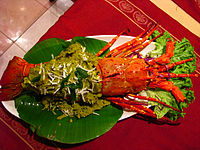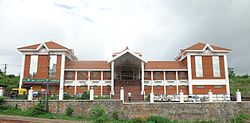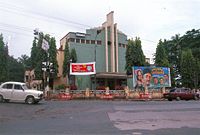- Culture of Mangalore
-
Mangalore (pronounced /ˈmæŋɡəlɔər/ (
 listen); Tulu: Kudla, ಕುಡ್ಲ; Kannada: ಮಂಗಳೂರು, Mangalūru; Konkani: Kodial, ಕೊಡಿಯಾಲ್; Beary: Maikala, ಮೈಕಾಲ) is the chief port city of the Indian state of Karnataka. A resident of Mangalore is known as a Mangalorean in English, Kudladaru in Tulu, Kodialgharano in Catholic Konkani, Kodyalkar in Konkani Language and Manglurnavaru in Kannada, Maikaaltanga in Beary bashe.
listen); Tulu: Kudla, ಕುಡ್ಲ; Kannada: ಮಂಗಳೂರು, Mangalūru; Konkani: Kodial, ಕೊಡಿಯಾಲ್; Beary: Maikala, ಮೈಕಾಲ) is the chief port city of the Indian state of Karnataka. A resident of Mangalore is known as a Mangalorean in English, Kudladaru in Tulu, Kodialgharano in Catholic Konkani, Kodyalkar in Konkani Language and Manglurnavaru in Kannada, Maikaaltanga in Beary bashe.Contents
Multiculturalism
Mangalore is a multicultural potpouri with people from diverse religious, linguistic, migratory classifications.
Tuluva Culture
Konkani Culture
There are about 22 ethnic Konkani communities live in Mangalore[1] including Goud Saraswat Brahmin, Mangalorean Catholics, Daivajna Brahmins, Kudmi, Kharvi, Gudigar, Navayats etc. The communities speak dialects of Konkani Language. Religious Festivals like Car Festivals of various Konkani Temples, Shigmo of Kudmi Community, Santhmarie of Catholics keep alive Konkani Cultural ethos.
The World Konkani Centre, built on a 3 Acre plot called Konkani Gaon (Konkani Village) at Shakti Nagar, Mangalore was inaugurated on 17 January 2009[2] “to serve as a nodal agency for the preservation and overall development of Konkani language, art and culture involving all the Konkani people the world over.”
Infrastructure
 A typical Yakshagana artist
A typical Yakshagana artist
The Srimanthi Bai Museum, which is located at Bejai, is the only museum of Mangalore.[3] The Bibliophile's Paradise, a hi-tech public library run by the Corporation Bank, is located at Mannagudda.[4] The Mangala Stadium, which is the only full-fledged stadium in Dakshina Kannada, is located in Mangalore.[5]
Practices
The Yakshagana is a night-long dance and drama performance practiced in Mangalore.[6][7] The Hulivesha (Tiger dance) is a folk dance unique to this area, which is performed during Dasara and Krishna Janmashtami.[8] Karadi Vesha (Bear Dance) is performed during Dasara in Mangalore.[9] Bhuta Kola or spirit worship, is practised here. Kambala or buffalo race is conducted in water filled paddy fields. Korikatta (Cockfight) is another favourite sport for the people. Nagaradhane or Snake worship is practised in the city according to the popular belief of the Naga Devatha to go underground and guard the species on the top.[10]
Pad'danas (Oral Epics) which are ballad-like folk epics narrated in Tulu are sung by the community of impersonators together with the rhythmic beats.[9] Some of the popular Beary songs are kolkai (sung during the play of kolata), unjal pat (sung while putting a child to cradle), moilanji pat and oppune pat (sung at weddings).[11] The Eucharistic Procession is an annual Catholic religious procession led on the first Sunday of the New Year of the Gregorian calendar.[9]
Festivals
The Ganesh Chaturthi festival is celebrated every year by erecting statues, worshipping them and immersing them in water bodies. Kodial Theru or Mangaluru Rathotsava (Mangalore Car Festival) is one of the major festivals of the GSB community, which celebrates the car festival of the Sri Venkatramana Temple.[12] Monti Fest is one of the major festivals of the Mangalorean Catholic community, celebrating the Nativity feast and the blessing of new crops.[13] The Jain Milan, a committee of the Jain families of Mangalore, organise the Jain Food Festival annually with a view to bring together all the members of the Jain community.[14] People of all faiths participate in the Mosaru Kudike, which is a part of the celebrations to mark the Krishna Janmashtami festival.[15] Annual festivals are promoted during summer each year, to promote Karavali Utsav and Kudlostava which encourages the local cultural events. In 2006, the Tulu film festival was organized in Mangalore.[16]
Cuisine
 Lobster neeruli, a local delicacy from the coastal city of Mangalore, where seafood is popular.[17]
Lobster neeruli, a local delicacy from the coastal city of Mangalore, where seafood is popular.[17]
 Neer dosa, a variant of dosa is native to Mangalore
Neer dosa, a variant of dosa is native to Mangalore
Mangalorean cuisine is largely influenced by South Indian cuisine. Mangalorean curry uses a lot of coconut and curry leaves. Ginger, garlic and chili is also used in curry. Mangalorean fish curry is known for its taste in the whole of Canara. Dishes of the Tulu community include Kori Rotti, Bangude Pulimunchi, Beeja-Manoli Upkari, Neer dosa, Boothai Gasi, Kadabu, and Patrode. The Konkani community has its specialities that include Daali thoy, beebe-upkari (cashew based), val val, avnas ambe sasam, Kadgi chakko. The Sanna-Dukra Maas (Sanna – idli fluffed with toddy or yeast; Dukra Maas – Pork) of the Mangalorean Catholics and the Mutton Biryani of the Mangalorean Muslims are well-known dishes. An assortment of pickles like happala, sandige and puli munchi are unique to Mangalore. Khali (toddy), a country liquor prepared from the coconut flower's sap is a well-known liquor of Mangalore.[9] The vegetarian cuisine is same as Udupi cuisine. Since Mangalore is a coastal town, Fish forms the staple diet of most people.
References
- ^ Suvarna Karnatakanthlya Konkani Lok; Fr. Richard Rego
- ^ http://www.daijiworld.com/news/news_disp.asp?n_id=55810
- ^ "Srimanthi Bai Museum is in a shambles". The Hindu. http://www.hinduonnet.com/2006/07/07/stories/2006070717580300.htm. Retrieved 2008-01-21.
- ^ Raviprasad Kamila (2006-04-01). "It's a treasure of books". Chennai, India: The Hindu. http://www.hindu.com/mp/2006/04/01/stories/2006040100730100.htm. Retrieved 2008-01-31.
- ^ "Minister keen on improving sports infrastructure". Chennai, India: The Hindu. 2006-08-07. http://www.hindu.com/2006/08/07/stories/2006080716740300.htm. Retrieved 2008-02-18.
- ^ "Yakshagana". SZCC, Tamil Nadu.. Archived from the original on 2007-08-17. http://web.archive.org/web/20070817224137/http://www.szcc.tn.nic.in/07_folktheatre/karnataka/Yakshagana/yakshagana.html. Retrieved 2007-12-07.
- ^ Plunkett, Richard (2001). South India. Lonely Planet. pp. 53. ISBN 1864501618. http://books.google.com/books?id=JmL9KqczbRYC&pg=PA53&lpg=PA53&dq=yakshagana+unique&source=web&ots=9_wX6OlWh7&sig=XiF-XEq63YZk_82YJTGM2ofzi60#PPA53,M1.
- ^ Pinto, Stanley G (2001-10-26). "Human `tigers' face threat to health". Times of India. http://timesofindia.indiatimes.com/articleshow/354160109.cms. Retrieved 2007-12-07.
- ^ a b c d Stephen D'Souza. "What's in a Name?". daijiworld.com. http://www.daijiworld.com/chan/exclusive_arch.asp?ex_id=726. Retrieved 2008-03-04.
- ^ "Nagarapanchami Naadige Doddadu". Mangalorean.Com. http://mangalorean.com/news.php?newstype=broadcast&broadcastid=50662. Retrieved 2008-01-28.
- ^ "Beary Sahitya Academy set up". Chennai, India: The Hindu. 2007-10-13. http://www.hindu.com/2007/10/13/stories/2007101361130300.htm. Retrieved 2008-01-15.
- ^ "Shri Venkataramana Temple (Car Street, Mangalore)". OurKarnataka.Com,Inc. http://www.ourkarnataka.com/states/mangalore/shrivenkataramanatemple.htm. Retrieved 2008-03-20.
- ^ John B. Monteiro. "Monti Fest Originated at Farangipet – 240 Years Ago!". daijiworld.com. http://www.daijiworld.com/chan/exclusive_arch.asp?ex_id=129. Retrieved 2008-01-11.
- ^ Amrita Nayak (2007-11-24). "Food for thought". Chennai, India: The Hindu. http://www.hindu.com/mp/2007/11/24/stories/2007112450980400.htm. Retrieved 2008-01-18.
- ^ "`Mosaru Kudike' brings in communal harmony". Chennai, India: The Hindu. 2005-08-28. http://www.hindu.com/2005/08/28/stories/2005082812400300.htm. Retrieved 2008-02-22.
- ^ "Tulu film festival". Chennai, India: The Hindu. 2006-02-23. http://www.hindu.com/2006/02/23/stories/2006022315050300.htm. Retrieved 2008-01-19.
- ^ http://www.hinduonnet.com/thehindu/mp/2005/10/15/stories/2005101503560400.htm
Categories:- Culture of Karnataka
- Culture of Mangalore
Wikimedia Foundation. 2010.


